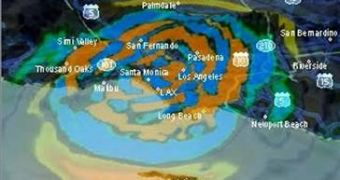I bet that would not be too happy to experinece a real earthquake. But if you want a blush of adrenaline, you could experience a "life-threatening earthquake" watching a supercomputer-generated, 3-D movie 30 minutes of the first jolt.
A digital chain reaction is being developed by researchers at Caltech and the San Diego Supercomputer Center, employing a network of ground sensors and supercomputers to transform an earthquake into a near real-time animated movie that the public can enjoy on their PCs or on TV as soon as the news breaks. This will be the first movie of this type available to the media the next time an earthquake of a magnitude-3.5 or over hits Southern California, a phenomenon that can happen anytime there.
"When an earthquake rattles Southern California, seismic recorders scattered at hundreds of stations across the earthquake-prone region constantly measure ground motion, providing seismologists with information to determine the temblor's epicenter, depth and intensity," said Jeroen Tromp, a computational seismologist of Caltech who works with SDSC to make the movies.
Earthquakes with a magnitude of at least 3.5 typically occur once or twice monthly in southern California, and the data is delivered to a SDSC supercomputer called OnDemand. This can realize a simulation of the ground movement in the area within about 28 minutes, instead of hours or days.
The OnDemand is a Dell cluster operated by a Linux software and made up of 256 processors. Peak performance could be of 2.4 teraflops.
The computer simulation also used archived data about the subsurface structure of the area, which has a crucial role in determining the behavior of the seismic waves out from the earthquake's epicenter. For example, when seismic waves cross soft sediments, they decrease speed and amplify, while the hard rocks increase the waves' speed. "We're getting good performance that will let us cut the time to deliver earthquake movies from about 45 to 30 minutes or less, and every minute is important," Tromp said.
The detailed information about earthquakes ensures a rapid delivery of emergency services to victims. Another team of seismologists and computer scientists has developed simulations (movies) of future California quakes, including the "big one", the most dreaded one.
The SDSC simulation also explains how most earthquakes act. The TeraShake project points that the induced shake of a 143-mile (230-kilometer) length of the San Andreas Fault slides would generate a magnitude-7.7 earthquake.

 14 DAY TRIAL //
14 DAY TRIAL //